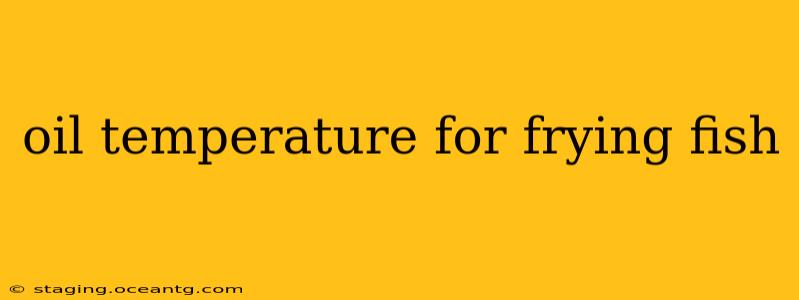Frying fish is a culinary art that, when done correctly, yields incredibly crispy, flaky results. However, getting the oil temperature just right is crucial for achieving that perfect texture and avoiding soggy, greasy disappointment. This guide will explore the ideal oil temperature for frying fish, along with tips and tricks for frying success.
What is the ideal oil temperature for frying fish?
The optimal oil temperature for frying fish is generally between 350°F (175°C) and 375°F (190°C). Using a thermometer is essential for accuracy. Too low, and your fish will absorb too much oil, resulting in a greasy texture. Too high, and the outside will burn before the inside is cooked through. We'll delve into the consequences of incorrect temperatures further below.
How do I know if my oil is the right temperature?
There are several ways to check your oil temperature:
- Thermometer: The most accurate method is using a deep-fry thermometer. Simply clip it to the side of your pan and monitor the temperature as the oil heats.
- Breadcrumb Test: Drop a small breadcrumb into the oil. If it sizzles and floats to the surface within a few seconds, your oil is ready.
- Water Drop Test: (Use with caution!) Carefully drop a small drop of water into the oil. If it sizzles and dances on the surface before evaporating, the oil is at the right temperature. However, this method can cause spattering, so be mindful of safety.
What happens if the oil temperature is too low?
If your oil temperature is too low (below 350°F), your fish will likely absorb excessive amounts of oil, leading to a greasy, soggy texture. The fish may also take longer to cook, resulting in an unevenly cooked product.
What happens if the oil temperature is too high?
Conversely, if your oil is too hot (above 375°F), the outside of your fish will burn before the inside cooks properly. You’ll end up with a dark, charred exterior and a raw or undercooked interior. This can also lead to the formation of harmful acrylamide compounds.
What types of oil are best for frying fish?
Choosing the right oil is equally important. Oils with high smoke points are ideal for frying, as they can withstand higher temperatures without breaking down and releasing harmful compounds. Excellent choices include:
- Canola oil: A neutral-flavored oil with a high smoke point.
- Vegetable oil: Another good option with a high smoke point and neutral flavor.
- Peanut oil: Has a slightly nutty flavor and a high smoke point.
Avoid oils with low smoke points, such as olive oil, as they can easily burn at frying temperatures.
How to maintain consistent oil temperature while frying?
Maintaining a consistent oil temperature throughout the frying process is vital. Avoid overcrowding the pan; adding too much fish at once will lower the oil temperature significantly. Fry in batches to ensure even cooking and maintain the optimal temperature.
What about different types of fish? Do they need different temperatures?
While the temperature range of 350°F to 375°F is generally suitable for most fish, thicker fillets might require slightly longer cooking times at the lower end of the range to ensure they are cooked through without burning. Thinner fillets, on the other hand, may cook more quickly at the higher end. Always check for doneness using a thermometer or by visually inspecting the fish. It should be opaque and easily flake with a fork.
By following these tips and using a thermometer, you can ensure that your next batch of fried fish is crispy, flavorful, and cooked to perfection. Remember, patience and attention to detail are key to success in the kitchen.
